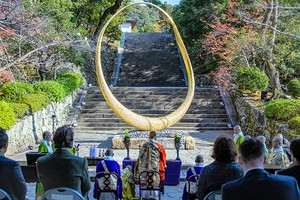By HIRAKU HIGA/ Staff Writer
August 22, 2023 at 07:00 JST
The Japanese company that pioneered the instant noodle revolution is now ready to tickle the taste buds of consumers who crave the taste of eel but rarely indulge due to the high price and relative scarcity of domestic “unagi.”
In spring 2019, Nissin Food Products Co. directed its cup ramen professionals to develop imitation eel exclusively from plant-derived material. It has taken this long for the company to bring its concept to fruition.
This was due to the fact that the Japanese eel is designated by the Environment Ministry as an endangered species, which has led to fake eel products made of fish paste and other ingredients flooding the market.
On that spring day four years ago, senior officials of Nissin gathered in a meeting room within the corporation’s office.
At the time, Nissin was starting to develop an eel substitute based on ground seafood. This was in line with what other manufacturers of convenience foods were doing because of poor fish hauls.
At the gathering, one of the managers exhorted the development team members to “aim higher now that you have been given the chance to create” an eel alternative.
The official’s use of the word “higher” reflected growing interest in the use of soybeans and other plants as meat substitutes.
As such, the comment was taken to mean that Nissin was ready to embrace the challenge of realizing sustainable food development, rather than simply offering something resembling eels.
TRIAL AND ERROR
The first prototype was ready that summer. It was tested at a monthly sampling session for executives.
Comparing it with freshly broiled unagi, most of those in attendance agreed that the imitation eel’s color and shape matched the real thing but still “lacked something.”
Improvements initially focused on the texture of the imitation product and how it felt in the mouth. The key issue was making the fake eel more like the real thing. To this end, the prototype was analyzed from three aspects: its white flesh, skin and intermediate layer between them.
Soybean protein particles were added to the white flesh to render it soft and flaky. Botanical oil was used for the layer between the flesh and the skin for a creamy touch.
Each of the three layers was then adjusted to resemble freshly cooked unagi.
This involved refining the fat content. A unique mayonnaise-like viscosity level was achieved after altering the volume and consistency of the fat.
Instant noodle specialists, who embody Nissin’s food re-creation technology, were in charge of the initiative from start to finish.
In total, 10 “pro reproducers” from different divisions threw everything they had into making the product as authentic as possible in terms of appearance and flavor as well as the fiber of the flesh and its muddy odor. They fine-tuned the fat, seasoning and aroma to achieve a perfect balance.
The imitation eel was perfected this past spring after a three-and-a-half-year effort.
“I fooled a junior employee from another department who tried it,” said a beaming Takateru Nakayama, who heads the product’s research and development team.
With his many years creating toppings for instant ramen, Nakayama, 50, expressed confidence in the quality of his latest brainchild.
The fake eel went on sale on Nissin’s shopping site on July 18 on a limited basis, and all 1,000 packages were snatched up, reportedly in a minute.
THE COMPETITION
Other businesses are also forging ahead with the development of eel substitutes.
Kanetetsu Delica Foods Inc. in Kobe’s Higashi-Nada Ward created imitation eel with fish paste in 2018. Using the same sauce used for unagi, the ground seafood is cooked in a grilled eel production facility in Shizuoka Prefecture.
Azuma Foods Co. in Komono, Mie Prefecture, conducted trial sales of 100 pieces of a plant-derived eel alternative in July 2022. Tofu and soybeans were used for the flesh, while its skin was replicated with “konbu” kelp.
LOWER CATCH, HIGHER PRICE
Ninety-nine percent of domestic eels for the Japanese market are farmed.
Juvenile eels known as elvers are caught in seas and rivers with the aim of nurturing them in aquaculture pools.
The catch for young eels in Japan for this fishing season from last November through May this year came to 5.7 tons, according to an estimate by the Fisheries Agency. The figure was about one-quarter of the 20 or so tons during the 2000s.
The average trading price per kilogram of young eel was 160,000 yen ($1,135) in 2003 but is now 2.5 million yen.




















A peek through the music industry’s curtain at the producers who harnessed social media to help their idols go global.
A series based on diplomatic documents declassified by Japan’s Foreign Ministry
Here is a collection of first-hand accounts by “hibakusha” atomic bomb survivors.
Cooking experts, chefs and others involved in the field of food introduce their special recipes intertwined with their paths in life.
A series about Japanese-Americans and their memories of World War II